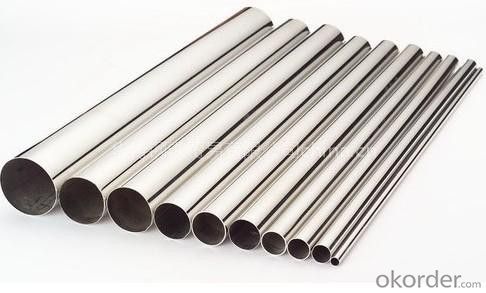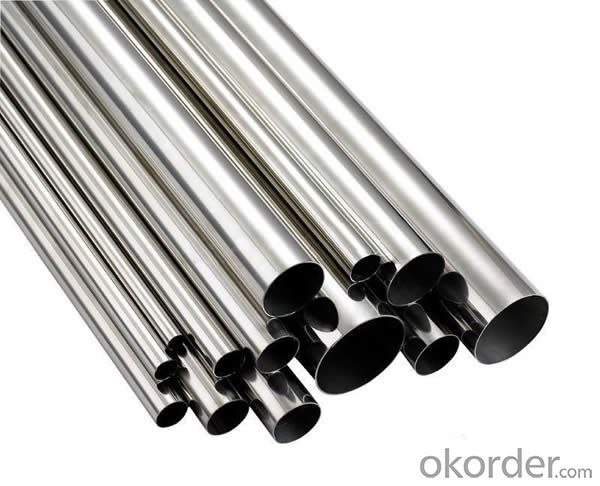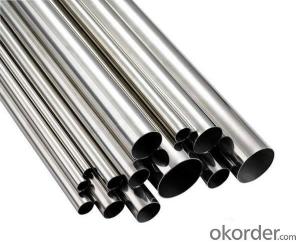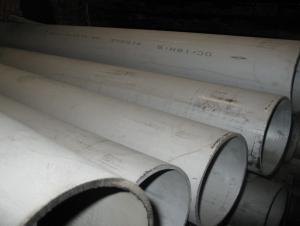Boiler Heat Exchange Stainless Steel Pipe 2205
- Loading Port:
- Tianjin
- Payment Terms:
- TT OR LC
- Min Order Qty:
- 1 m.t.
- Supply Capability:
- 1000 m.t./month
OKorder Service Pledge
OKorder Financial Service
You Might Also Like
Product Description:
1、Structure of Boiler Heat Exchange Stainless Steel Pipe 2205 ASTM A213 Description:
Boiler Heat Exchange stainless steel pipe is often used in the heating system. Heating system, or those stored energy (such as solar energy) in the form of heat, need to be built with the material that can withstand temperatures up to 550 degrees Celsius. High chromium molybdenum welded steel pipe can work in the extreme, which maintain as the ideal material for the construction of power station.
2、Main Features of Boiler Heat Exchange Stainless Steel Pipe 2205 ASTM A213:
• High manufacturing accuracy
• High strength
• Small inertia resistance
• Strong heat dissipation ability
• Good visual effect
•Reasonable price
3、Boiler Heat Exchange Stainless Steel Pipe 2205 ASTM A213 Images:



4、Boiler Heat Exchange Stainless Steel Pipe 2205 ASTM A213 Specification:
1)Commodity: heat exchanger pipe
2))Material: 304,316L,304L,316,321,310S,etc
3)Thickness:0.5-100mm
4)Length: 1-14m
| Material Grade | 304,304L,316 ,316L,321,310S,2205,904and so on. |
| Standard | ASTM A312, A554, A249, A269 and A270,ect |
| DIN 17456-85 , DIN 17458-85, DIN 17459-92,ect | |
| JIS G3446-1994, JIS G3448-1997, JIS G3459-1997, JIS G3463-1994,ect | |
| GB13296-1991, GB14975-2002, GB14976-2002,ect | |
| Outer Diameter | 13.7-2020mm |
| Thickness | 0.5-50mm |
| Length | 1m -12m or as customers' request |
| Polish | 180G, 320G, 400G Satin / Hairline |
| 400G, 500G, 600G or 800G Mirror finish | |
| Test | eddy current inspection, ultrasonic inspection, X-ray inspection, real-time imaging, hydrostatic test, spectral analysis, intergranular corrosion, water pressure test, and mechanical property testing facilities. |
| Payment | 1) by L/C at sight, |
| 2) 30% deposit, 70% balance before Shipping. | |
| Delivery time | A.7 days if this goods is stock goods. |
| B.25 days if this goods will be produced after order | |
| Validity | Valid time is 3 days for price usually. |
| Payment terms | FOB Tianjin |
| MOQ | 1 ton |
| Capacity | 1000 ton per month |
| Certificate | ISO, SGS, and third part inspection |
| Applications | the products are widely used in chemical industry, condenser pipe, heat exchanger, petroleum, shipping military, environment protection, high temperature resistant, low temperature resistant, corrosion resistant and so on. |
| packing details | 1) Wooden-box Package. 2) The Wooden Frame Packing. 3) Intertexture Cloth Packaging with the Iron Sheet Bonding and the Two Terminals Covered With Plastic Dome. |
5、FAQ of Boiler Heat Exchange Stainless Steel Pipe 2205 ASTM A213 :
①How is the quality of your products?
Our products are manufactured strictly according to national and internaional standard, and we take a test on every pipe before delivered out. If you want see our quality certifications and all kinds of testing report, please just ask us for it.
Guaranteed: If products’ quality don’t accord to discription as we give or the promise before you place order, we promise 100% refund.
②How about price?
Yes, we are factory and be able to give you lowest price below market one, and we have a policy that “ for saving time and absolutely honest business attitude, we quote as lowest as possible for any customer, and discount can be given according to quantity”,if you like bargain and factory price is not low enough as you think, just don’t waste your time.Please trust the quotation we would give you, it is professional one.
③Why should you chose us?
Chose happens because of quality, then price, We can give you both.Additionally, we can also offer professional products inquiry, products knowledge train(for agents), smooth goods delivery, exellent customer solution proposals.Our service formula: good quality+good price+good service=customer’s trust
SGS test is available, customer inspection before shipping is welcome, third party inspection is no problem.
Any question, pls feel free to contact us !
- Q:What is the tensile strength of stainless steel pipes?
- The tensile strength of stainless steel pipes can vary depending on the specific grade and manufacturing process, but it typically ranges from 515 to 827 megapascals (MPa) or 74,800 to 119,900 pounds per square inch (psi).
- Q:Are stainless steel pipes suitable for industrial applications?
- Stainless steel pipes excel in industrial settings due to their exceptional corrosion resistance, rendering them a favored option across various industries such as chemical, petrochemical, oil and gas, pharmaceutical, food and beverage, and more. These pipes can endure elevated temperatures and pressures, making them perfect for transporting fluids and gases in industrial procedures. Moreover, their durability, strength, and prolonged lifespan become pivotal in heavy-duty industrial scenarios. Furthermore, stainless steel pipes necessitate effortless maintenance and cleaning, mitigating the risk of contamination in industries that mandate stringent hygiene standards. In summary, stainless steel pipes present myriad advantages that render them highly suitable and extensively employed in industrial applications.
- Q:What is the difference between 304J7 and 316J7 stainless steel pipes?
- The main difference between 304J7 and 316J7 stainless steel pipes lies in their composition and properties. 304J7 stainless steel is a standard austenitic grade with good corrosion resistance and high strength, suitable for general applications. On the other hand, 316J7 stainless steel is a molybdenum-bearing austenitic grade with superior corrosion resistance, particularly in environments with chlorides or other corrosive agents. Therefore, 316J7 stainless steel pipes are often used in industries such as marine, chemical, and food processing where corrosion resistance is critical.
- Q:Can stainless steel pipes be bent or shaped?
- Yes, stainless steel pipes can be bent or shaped. Stainless steel has good ductility and can be easily formed into various shapes and configurations. The most common method used for bending stainless steel pipes is through the use of specialized equipment such as pipe bending machines or hydraulic presses. These tools apply pressure to the pipe at specific points, causing it to bend or form into the desired shape. The degree of bend or shaping will depend on factors such as the diameter and thickness of the pipe, as well as the required angle or curvature. It is important to note that the bending process should be done carefully to avoid any damage or deformation to the stainless steel pipe.
- Q:Can stainless steel pipes be coated with fusion bonded epoxy?
- Indeed, it is possible to apply fusion bonded epoxy (FBE) coating to stainless steel pipes. FBE, a thermosetting powder coating, is commonly utilized as a protective coating against corrosion for various pipe types, including carbon steel, ductile iron, and stainless steel. The FBE coating offers exceptional adhesion, corrosion resistance, and impact resistance to stainless steel pipes, thereby prolonging their lifespan and reducing maintenance demands. The FBE coating process entails the application of the powder coating onto the preheated pipe surface, which subsequently melts and forms a consistent, safeguarding layer. This coating is extensively employed in industries like oil and gas, water treatment, and sewage systems, serving as a defense mechanism against corrosion and other environmental factors for stainless steel pipes.
- Q:How do you join stainless steel pipes together?
- To join stainless steel pipes together, there are several methods available, depending on the specific requirements and application. 1. Welding: Welding is the most common and widely used method for joining stainless steel pipes. It involves the application of heat to melt the material, forming a strong and durable bond. Different welding techniques like TIG (Tungsten Inert Gas) or MIG (Metal Inert Gas) welding can be used for this purpose. 2. Compression fittings: Compression fittings are a popular choice for joining stainless steel pipes, especially in plumbing applications. These fittings consist of a compression nut and a ferrule that are tightened onto the pipe, creating a secure and leak-proof connection. 3. Flanges: Flanges are used when a more robust connection is required, such as in high-pressure or high-temperature applications. Two stainless steel pipes are joined together by bolting flanges at the ends, creating a tight and reliable connection. 4. Threaded connections: Stainless steel pipes can also be joined using threaded connections, where one end of the pipe is threaded and the other end is fitted with a threaded pipe fitting, such as a union or nipple. This method is commonly used for smaller diameter pipes or in situations where disassembly may be required. 5. Clamps and couplings: Clamps and couplings are used to join stainless steel pipes temporarily or in situations where frequent disassembly is required. These devices clamp around the pipes and are tightened using bolts or other mechanisms, creating a secure connection. It is important to consider the specific requirements, such as pressure, temperature, and corrosion resistance, when choosing the appropriate method to join stainless steel pipes. Consulting with a professional or referring to industry standards and guidelines can ensure a successful and reliable pipe connection.
- Q:Can stainless steel pipes be used for wastewater pumping stations?
- Yes, stainless steel pipes can be used for wastewater pumping stations. Stainless steel is a highly durable and corrosion-resistant material, making it suitable for applications involving wastewater transportation. It can withstand the harsh and corrosive environment of wastewater pumping stations, ensuring long-term reliability and minimal maintenance requirements. Additionally, stainless steel pipes have excellent mechanical properties, making them capable of withstanding the high pressures and temperature variations commonly encountered in wastewater pumping systems.
- Q:Can stainless steel pipes be powder coated?
- Stainless steel pipes have the capability to undergo powder coating. Powder coating, a technique employed to furnish metal surfaces with both a safeguarding and embellishing finish, is involved. To achieve this, a dry powder coating is applied onto the stainless steel pipes' surface, and subsequently, it is solidified through heat. This process yields a robust and sleek coating. Powder coating is frequently employed to augment the visual appeal of stainless steel pipes, bestow supplementary resistance against corrosion, and safeguard against deterioration caused by weather and usage. Nonetheless, it is crucial to acknowledge that stainless steel pipes necessitate appropriate preparation prior to powder coating to ensure adhesion and achieve optimal outcomes.
- Q:Are stainless steel pipes suitable for food and beverage processing?
- Yes, stainless steel pipes are highly suitable for food and beverage processing. They are corrosion-resistant, easy to clean, and do not leach any harmful substances into the products being processed. Additionally, stainless steel pipes maintain the quality and taste of the food and beverages, making them a popular choice in the industry.
- Q:Can stainless steel pipes be used for hygienic applications?
- Yes, stainless steel pipes can be used for hygienic applications. Stainless steel is a highly durable and corrosion-resistant material that is commonly used in industries where hygiene is of utmost importance, such as food and beverage, pharmaceutical, and biotechnology sectors. Stainless steel pipes have a smooth surface that prevents the growth of bacteria and other microorganisms, making them suitable for applications where cleanliness is crucial. They are also easy to clean and maintain, as the smooth surface allows for efficient and thorough cleaning, reducing the risk of contamination. Moreover, stainless steel pipes are non-reactive and do not release any harmful substances into the products being transported. This makes them ideal for applications where sanitary conditions are essential, such as in the production and transportation of food, beverages, and pharmaceuticals. Additionally, stainless steel pipes have excellent resistance to high temperatures, chemicals, and corrosion, ensuring the integrity of the system and preventing any contamination or leaks. They are also highly durable and can withstand harsh operating conditions, making them a reliable choice for hygienic applications. In conclusion, stainless steel pipes are suitable for hygienic applications due to their durability, corrosion resistance, smooth surface, ease of cleaning, and non-reactivity. They provide a reliable and sanitary solution for industries where hygiene is a top priority.
1. Manufacturer Overview |
|
|---|---|
| Location | |
| Year Established | |
| Annual Output Value | |
| Main Markets | |
| Company Certifications | |
2. Manufacturer Certificates |
|
|---|---|
| a) Certification Name | |
| Range | |
| Reference | |
| Validity Period | |
3. Manufacturer Capability |
|
|---|---|
| a)Trade Capacity | |
| Nearest Port | |
| Export Percentage | |
| No.of Employees in Trade Department | |
| Language Spoken: | |
| b)Factory Information | |
| Factory Size: | |
| No. of Production Lines | |
| Contract Manufacturing | |
| Product Price Range | |
Send your message to us
Boiler Heat Exchange Stainless Steel Pipe 2205
- Loading Port:
- Tianjin
- Payment Terms:
- TT OR LC
- Min Order Qty:
- 1 m.t.
- Supply Capability:
- 1000 m.t./month
OKorder Service Pledge
OKorder Financial Service
Similar products
New products
Hot products
Hot Searches
Related keywords





























